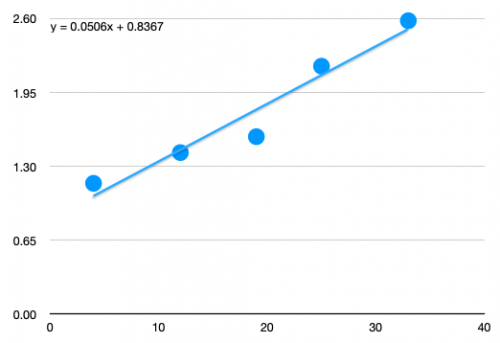The data collection plods on. I’ve added body length measurements for my growing Steatoda triangulosa babies, and they’re coming along nicely. What you’re seeing here is body length in mm vs days after emergence.
They molted on day 22, which accounts for the slower rate between the 2nd and 3rd timepoint — once they shed that constraining cuticle, growth rebounded nicely.
There is some variation in the individual growth rates. The smallest baby is 2.1mm long, the largest is 3.4mm. They’ve also gotten much harder to measure, because they’re more active and get more annoyed at being put under the microscope. I had to drop two of them from this week’s measurement because they wouldn’t cooperate and lie in an appropriate orientation.
I’m experimenting now with an alternative method of keeping the ones I’m recording: I made simple paper strips in a circle, sandwiched between two petri dishes. The plan is to get them to build their cobwebs in that, and then I remove the petri dishes and have the spiders hanging in a ring that I can orient any way I want and get some more standard alignments for comparison. The poor babies hate being shuffled around, but they also like hanging stationary, so it might work — the initial manipulation might get them agitated, but then if I’m patient they’ll settle down and pose for me.
Isn’t it fun to tinker in the lab?



“They molted on day 22, which accounts for the slower rate between the 2nd and 3rd timepoint — once they shed that constraining cuticle, growth rebounded nicely.”
That’s interesting. I guess the cuticles must be a bit elastic, which had never occured to me. I assume there is a pretty tight limit on that elasticity, though, so I expect growth rates to be much more zigzaggy as the babies get adult sized.
Lobsters, AFAIK, never stop growing as long as they live. Is that true of spiders?
Maybe, but they tend not to live long. At least not these little guys I work with.
And yeah, spiders are a bit squishy — they’re not as rigidly armored as some arthropods.
I’m not sure it will be useful, maybe it is how are you doing it, but have you tried to just photo them on millimeter paper and use it as a scale for comparison? You can backlight the paper so shadows will not be an issue.
Or you can create custom print with checkerboard of defined size (0.5mm, or 0.2 mm) and colors that would be contrasting to color of the spiders….
It may be completely useless in your case but sometimes stupidly simple is not that stupid….
Damn, I was hoping for exponential growth.